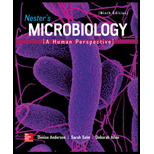
Concept explainers
To review:
The nonenveloped viruses are more resistant than enveloped viruses to disinfectants.
Introduction:
Viruses are the microscopic infectious agents, which consist of a
Explanation of Solution
The capsid protects the nucleic acid particle from the actions of chemicals, environment, and digestive enzymes present in the body of the host. The nucleic acid encodes for the various enzymes and other materials needed by the virus for causing the infection in the living cells of the host.
The capsid, present along with the nucleic acid present in it, is known as the nucleocapsid. There are some viral strains found, which consist of a bilipid layer around the nucleocapsid as an envelope. Such viruses are called the enveloped viruses and the viruses without it regarded as the nonenveloped viruses or naked viruses. The envelope consists of spikes that help the viruses to attach to the cell of the host.
Disinfectants are the chemicalsthatare used to kill the microbes and sterilize the material. The enveloped viruses are more prone toward the action of these chemicals than the nonenveloped viruses. This is so because the disinfectants damage the spikes present on the envelope layer and thus inhibits the noninfectious nature of the viruses as they can no more attach to the host’s cells to cause the infection.
Therefore, the nonenveloped viruses are not susceptible to the action of the disinfectants as compared to the enveloped one. This is because the lipid envelope in the enveloped viruses gets destroyed by these chemicals.
Want to see more full solutions like this?
Chapter 13 Solutions
Nester's Microbiology: A Human Perspective
- In one paragraph show how atoms and they're structure are related to the structure of dna and proteins. Talk about what atoms are. what they're made of, why chemical bonding is important to DNA?arrow_forwardWhat are the structure and properties of atoms and chemical bonds (especially how they relate to DNA and proteins).arrow_forwardThe Sentinel Cell: Nature’s Answer to Cancer?arrow_forward
- Molecular Biology Question You are working to characterize a novel protein in mice. Analysis shows that high levels of the primary transcript that codes for this protein are found in tissue from the brain, muscle, liver, and pancreas. However, an antibody that recognizes the C-terminal portion of the protein indicates that the protein is present in brain, muscle, and liver, but not in the pancreas. What is the most likely explanation for this result?arrow_forwardMolecular Biology Explain/discuss how “slow stop” and “quick/fast stop” mutants wereused to identify different protein involved in DNA replication in E. coli.arrow_forwardMolecular Biology Question A gene that codes for a protein was removed from a eukaryotic cell and inserted into a prokaryotic cell. Although the gene was successfully transcribed and translated, it produced a different protein than it produced in the eukaryotic cell. What is the most likely explanation?arrow_forward
- Molecular Biology LIST three characteristics of origins of replicationarrow_forwardMolecular Biology Question Please help. Thank you For E coli DNA polymerase III, give the structure and function of the b-clamp sub-complex. Describe how the structure of this sub-complex is important for it’s function.arrow_forwardMolecular Biology LIST three characteristics of DNA Polymerasesarrow_forward
 Biology (MindTap Course List)BiologyISBN:9781337392938Author:Eldra Solomon, Charles Martin, Diana W. Martin, Linda R. BergPublisher:Cengage Learning
Biology (MindTap Course List)BiologyISBN:9781337392938Author:Eldra Solomon, Charles Martin, Diana W. Martin, Linda R. BergPublisher:Cengage Learning Biology Today and Tomorrow without Physiology (Mi...BiologyISBN:9781305117396Author:Cecie Starr, Christine Evers, Lisa StarrPublisher:Cengage Learning
Biology Today and Tomorrow without Physiology (Mi...BiologyISBN:9781305117396Author:Cecie Starr, Christine Evers, Lisa StarrPublisher:Cengage Learning Medical Terminology for Health Professions, Spira...Health & NutritionISBN:9781305634350Author:Ann Ehrlich, Carol L. Schroeder, Laura Ehrlich, Katrina A. SchroederPublisher:Cengage LearningSurgical Tech For Surgical Tech Pos CareHealth & NutritionISBN:9781337648868Author:AssociationPublisher:Cengage
Medical Terminology for Health Professions, Spira...Health & NutritionISBN:9781305634350Author:Ann Ehrlich, Carol L. Schroeder, Laura Ehrlich, Katrina A. SchroederPublisher:Cengage LearningSurgical Tech For Surgical Tech Pos CareHealth & NutritionISBN:9781337648868Author:AssociationPublisher:Cengage





